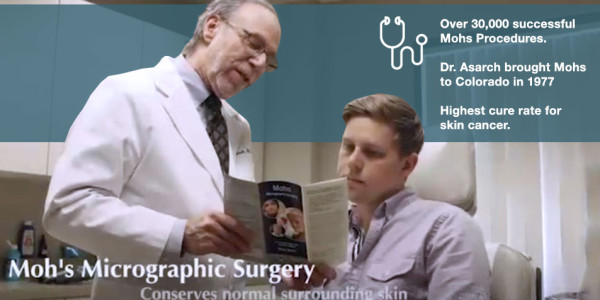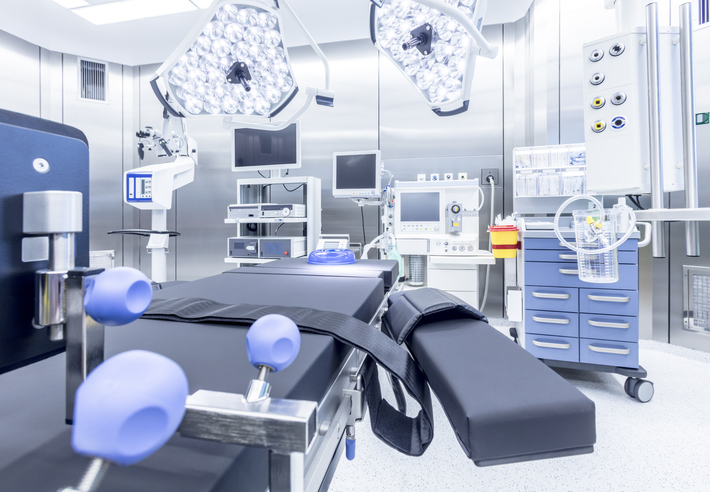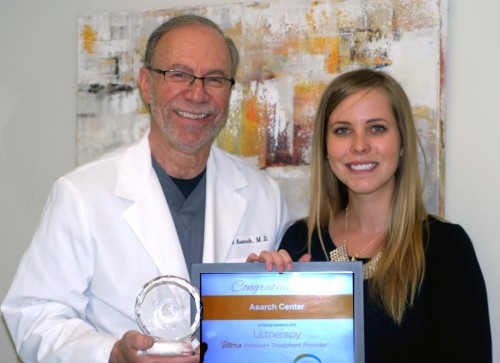Mohs Surgery

Skin Cancer is a very serious concern for patients in Colorado. Our increased altitude and high UV index put Coloradans at an even higher risk for developing skin cancer. When it comes to treatment, Mohs Surgery is the only treatment that ensures complete removal of cancer, virtually eliminating the chance of the cancer growing back.
Asarch Dermatology is the Leader in Mohs Surgery in Colorado. Dr. Richard Asarch and Dr. Twede have successfully performed over 30,000 Moh’s Surgery Procedures for the treatment of skin cancer.
Consider Mohs Surgery to:
- Ensure complete cancer removal
- Minimizing the amount of healthy tissue lost
- Maximize the functional and cosmetic outcome after surgery
- Repair the site of the cancer the same day the cancer is removed (in most cases)
- Cure skin cancer when other methods have failed
What is Mohs Surgery?
Initially developed by Dr. Frederic E. Mohs, Mohs is the most effective procedure for treating basal cell and squamous cell skin cancers, with the highest success rate of all skin cancer treatments. Mohs allows surgeons to identify and remove tumors one layer at a time while preserving as much healthy tissue as possible, minimizing discomfort and recovery time as much as possible.
Mohs Surgery is a groundbreaking, intricate, highly-effective method of curing skin cancer. Its 99.9% success rate speaks for itself.
At Asarch Center, we pride ourselves in being one of the premier Mohs surgery providers in the region. Dr. Richard Asarch was the first to bring the surgery to Colorado, and with over 30,000 procedures performed, he’s the best choice for your Mohs treatment.
ADVANTAGES OF MOHS SURGERY
Mohs surgery offers the highest cure rate among treatments for skin cancer and can be used for practically any type of skin cancer.
There are many advantages to Mohs surgery compared to other skin cancer treatments including its high cure rate and cost-effectiveness. Mohs is especially appropriate for skin cancers that:
- Develop on areas where preserving cosmetic appearance and function are important
- Have recurred after previous treatment or are likely to recur
- Are located in scar tissue
- Are large
- Have edges that are ill-defined
- Grow rapidly
What Cancers Can Mohs Treat?
Mohs surgery offers the highest cure rate among treatments for skin cancer and can be used for practically any type of skin cancer.
There are many advantages to Mohs surgery compared to other skin cancer treatments including its high cure rate and cost-effectiveness. Mohs is especially appropriate for skin cancers that:
-
- Develop on areas where preserving cosmetic appearance and function are important
- Have recurred after previous treatment or are likely to recur
- Are located in scar tissue
- Are large
- Have edges that are ill-defined
- Grow rapidly
If you think you have skin cancer, book a consultation with us today.
Mohs Surgery Procedure

After you sign a procedure consent form, you will undergo a numbing process with an injectable anesthetic. Once the area is numb, a thin incision will be performed around the visible skin cancer. Bleeding is normal during this process and, if encountered, electrocautery is often utilized to stop the bleeding. A temporary dressing will be placed over the wound.
The tissue will then be prepared and taken to the lab for processing. Removal of the initial piece of tissue takes only 10-15 minutes. However, it may take 1 hour or more to prepare and microscopically examine the tissues with each stage. Several surgical stages may be necessary to completely remove the tumor. Since it is often not possible to know the extent of skin cancer until it is examined microscopically, it is not possible to know how many stages your skin tumor will require. However, most are removed in three stages or less.
Usually, the Mohs process is completed within three to six hours, but in rare circumstances, surgery may take longer.
RECOVERY AFTER MOHS

Mohs has a considerably short recovery time compared to similar procedures. After the procedure, we ask that you go home and rest and that you do not return to work or other activities for the rest of the day. Exercise should be avoided for the first 2-7 days after surgery, but you will be given specific restrictions that will depend on the location and extent of your surgery. Mohs surgery is an outpatient procedure and does NOT require hospitalization, except in very rare instances.
If the wound is sutured, these will be removed in seven to ten days with minimum restrictions during that time. If not, a normal healing time, as with any other cut on your body, is all that is required and can vary from patient to patient.
There may be other appointments scheduled to assess your progress and healing. It is also imperative you continue to follow up with your referring medical provider to evaluate your skin for other skin cancers.
about dr. asarch
Dr. Asarch is Colorado’s First & Most Experienced Mohs Surgeon. Dr. Asarch received his specialized training with Dr. Mohs in 1977 and has performed over 30,000 procedures utilizing this technique for the removal of skin cancers. Dr. Asarch was the first doctor to bring this wonderful surgery to Colorado, and only in the last several years has the technique become widely available throughout the country. In 1981, he was recruited to create the dermatologic surgery program in the Department of Dermatology at the University of Colorado, which included utilizing the Mohs procedure.

Testimonials
“Unfortunately I have to visit this place for skin cancer. But the staff and doctor did everything to put me at ease. They were very kind. Dr. Asarch did a fabulous job you can’t even tell where they took out the cancer. Yes I would say he is an awesome doctor.”
“Appointment times are convenient. No delays in being seen. Dr. Twede does excellent work on Mohs procedures. The staff facilitates the quality of service. Good explanations are given regarding my conditions as well as how procedures are performed.”
Schedule a Consultation
If you are considering Mohs Surgery, please contact Asarch Center for Dermatology, Laser, & Mohs Surgery. Call us at 303-761-7797 to schedule a consultation. Our practice serves Englewood, Lakewood, Castle Rock, and surrounding areas in Colorado.
Mohs Surgery FAQs
How Does Mohs Work to Treat Skin Cancer?
Mohs surgery is unique and so effective because of the way the removed tissue is microscopically examined, evaluating 100% of the surgical margins.
The pathologic interpretation of the tissue margins is done on site by the Mohs surgeon Dr. James Twede, who is specially trained in the reading of these slides and is best able to correlate any microscopic findings with the surgical site on the patient. Advantages of Mohs surgery include:
- Ensuring complete cancer removal during surgery, virtually eliminating the chance of cancer growing back
- Minimizing the amount of healthy tissue lost
- Maximizing the functional and cosmetic outcome resulting from surgery
- Repairing the site of cancer the same day the cancer is removed, in most cases
- Curing skin cancer when other methods have failed
How is Mohs different than other options for removing skin cancer?
As mentioned across this page, Mohs is different than other methods for removing skin cancer in its accuracy. When skin cancer is removed by excision, cryotherapy, or electrocautery, there is always an element of guesswork involved. Did we get all the cancer? There’s no way to know. That’s why in many cases using these other methods, skin cancer returns at the site because residual cells remained after the initial removal.
Mohs is excisional surgery with the added element of immediate testing of the sample for cancer cells remaining on the borders. While this can make the removal process longer, as the patient needs to remain in our offices as we test the removed tissue and, if necessary, return and take another layer, it basically ensures you won’t need to return at a future date and do it all again.
Is Mohs surgery covered by my health insurance?
Yes. Removal of skin cancers is always covered by insurance. Mohs is simply one method.
How Can I PREPARe FOR MOHS SURGERY?
The Asarch Center performs Mohs Micrographic Surgery as an outpatient procedure in our office, with each patient having a private surgical suite.
Our on-site laboratory allows for immediate preparation and microscopic examination of tissue. Since the entire procedure is performed by Dr. Asarch in our own office, other than avoiding non-medically-indicated blood-thinning medications (Aspirin, vitamin E, fish oil, ibuprofen, etc) no other preparation is necessary. There are no eating restrictions as only local anesthesia is used.
You may wish to have someone accompany you to the surgery to chat with during the procedure and to take you home, but it is not required. We recommend you bring a book or any other form of entertainment that is quiet and can reside in your lap. This is especially helpful when you are waiting between the surgical stages. We also recommend you dress comfortable and consider bringing a sweater for added comfort.
Since we do not know in advance how much time will be required to remove your tumor and reconstruct the wound, we ask that you make no other commitments and be prepared to be in the office most of the day.
How long does Mohs surgery take?
There is no way to tell exactly how long your Mohs surgery with Dr. Asarch will take. Excising the initial ring of tissue with the lesion takes just 10-15 minutes. But it can take about an hour to prepare the tissue and examine it under the microscope. Then, if more cancer is found the process needs to be repeated. Generally, the complete removal takes three stages or less, but there isn’t any way to predict your personal situation. These surgeries can take from 3-6 hours.
Will I Have Any Scarring After Mohs Surgery?
As will any skin cancer treatment, Mohs surgery will leave a scar.
However, Mohs surgery preserves as much healthy skin as possible and maximizes your options for repairing the surgical defect once the tumor is completely removed. Once Dr. Asarch has completely removed your skin cancer through Mohs surgery, reconstruction for optimizing the final functional and cosmetic result becomes the highest priority. Generally, a post-surgical scar improves with time and can take up to 1 year or more to fully mature. As your surgical site heals, new blood vessels can appear and support the healing changes occurring underneath the skin. This can result in the reddish appearance of the scar, but it is only temporary and will improve with time.
In addition, the normal healing process involves a period of skin contraction, which often peaks 4 to 6 weeks after the surgery. This appears as a bumpiness or hardening of the scar. On the face, this change is nearly always temporary and the scar will soften and improve with time. If you have a history of abnormal scarring, such as hypertrophic scars or keloids, or if there are problems with the healing of your scar, injections or other treatments may be used to optimize the cosmetic result. Dr. Asarch is available for you throughout the healing process to discuss any concerns that may arise.
Risks of Mohs Surgery
Infection: Mohs surgery has a historically low 1-2% risk for infection. After your surgery, we ask that you look for signs and symptoms of infection that include redness extending ½ inch from the wound margin, drainage of pus, warmth, and pain. Please inform us if this occurs.
Bleeding: During the procedure, electrocautery and suturing may be used to stop the normal bleeding. Occasionally, a blood vessel will reopen and bleed many hours after the procedure. If you develop an oval bump or “knot” within the surgery site within the first 24-48 hours after the surgery please let us know right away.
Pain: Most patients have minimal pain after the procedure, often only requiring acetaminophen for pain control. If you have a particularly low tolerance for pain or have had significant pain with similar procedures in the past, please let us know so appropriate pain control measures can be provided.
Scar: Drs. Asarch and Twede will evaluate and customize the most appropriate repair technique to minimize your scar. Wound reconstruction options include suturing the wound, allowing the wound to heal on its own, and using a skin graft.
Are there any health issues that can be complicated by Mohs surgery?
Mohs surgery with Dr. Asarch is still surgery, so the patient needs to be able to have anesthesia and tolerate the stresses of surgery. Other than that, the success of this surgery makes it very low risk. The far greater risk is to not remove a skin cancer, no matter if it is basal cell, squamous cell, or melanoma.
I don’t see anything after my biopsy. Do I really need surgery?
Sometimes a patient assumes that when a suspicious lesion has been scraped with a curette and sent off for biopsy all the cancer must be gone. Nothing appears to show on the skin around where the biopsy was taken.
The problem is the cells surrounding the area of removal. When the biopsied sample comes back as being positive for skin cancer, there is a good likelihood that additional cancerous cells are still present outside of where the biopsy was taken. Visual examination will not show these cells, but if present they will begin to form new lesions. This is an especially dangerous line of thinking with melanoma, as untreated melanoma can grow downward and begin to deposit cancer cells into the bloodstream. These cells can go anywhere in the body and start new cancer growths.
Why does my skin cancer need to have Mohs surgery?
No one wants to have surgery in the first place, but who wants to have a second surgery when the first one could have completely handled whatever problem you have? That’s the way to think of Mohs surgery. In contrast to simple excision, where the surgeon is guessing whether or not he or she was able to remove all of the cancer cells, with Mohs processes it is virtually assured. That’s why Mohs surgery for skin cancer has a 99.9 percent success rate. That means you won’t have to have a second surgery when the first surgery doesn’t remove all the cancer.
Also, Mohs has the added advantage of removing the least amount of tissue. Again, contrast this with a typical excision. The surgeon is guessing the size of the lesion, so he or she takes a larger amount of tissue around the growth in the hope of removing all of the cancerous cells. With Mohs, Dr. Asarch removes the tissue layer by layer, and the tissue is then examined for the presence of cancerous cells at the borders. If cells remain, another ring or layer is removed, and this is then tested. When the borders are fully clear, that ends the procedure. There is no guesswork.
Is Mohs the Most Cost-Effective Option?
Mohs Micrographic Surgery is the most cost-effective treatment for skin cancer.
According to an article published in the April, 1982 issue of Dermatologic Surgery, Mohs Micrographic Surgery is the most cost-effective treatment for skin cancer. Mohs surgery offers low recurrence rates, smaller defects (resulting in simpler, less-costly repairs), and overall cost efficiency. The common misconception of Mohs surgery being an expensive option has its roots in the poorly-understood factor that the procedure includes costs of surgical excision, histology preparation, and pathology when in reality it’s a simple in-office procedure.
Where can Mohs surgery be done?
Mohs surgery can be performed anywhere the patient has skin cancer. This is true because the process means only the minimal amount of tissue has to be removed. As mentioned above, once the lesion and some surrounding border tissue are removed it is tested for the presence of cancer cells in the border. This process ensures that only the minimum amount of skin is removed. That makes Mohs surgery the best method for anywhere on the body. This, of course, is especially true on areas where cosmetic appearance is important, such as the face.
Interested in learning more about Mohs Surgery in the Englewood and Castle Rock, CO area? Call us at 303-761-7797 to schedule a consultation and learn more!
